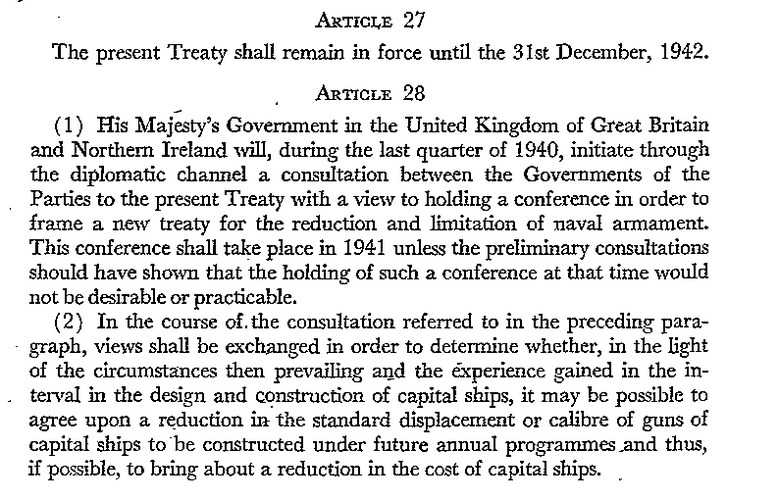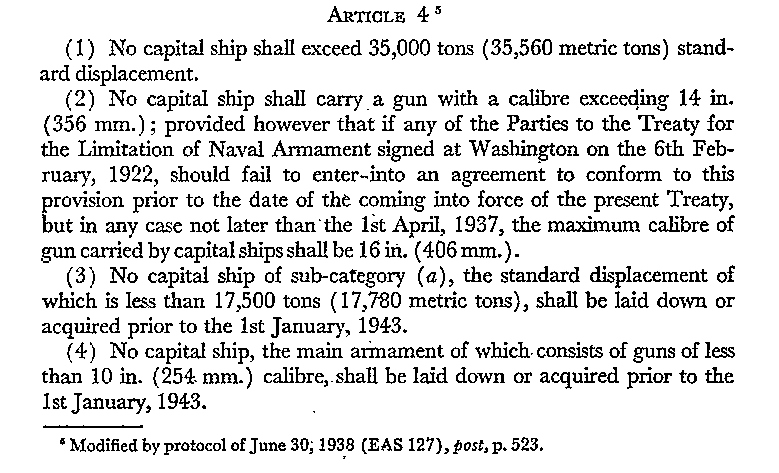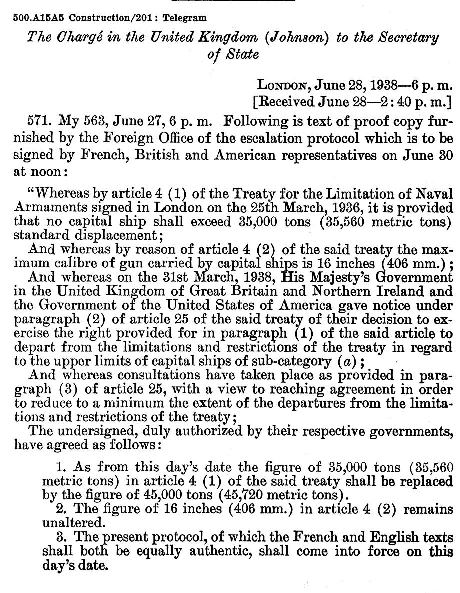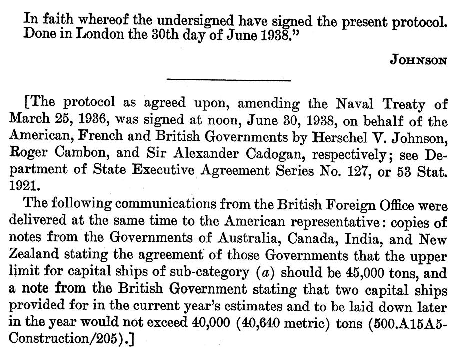As for a complete redesign, it needs to be remembered that the 1936 London Treaty carrier limit of 23,000 tons is still in place in 1938 when the design is being worked through. You know by the end of 1938 that war is coming but you don't know when.
Not examining treaty breaking options seems illogical. Such would be subject to secrecy and inform the possible political negotiations and is good contingency planning.
The previous naval treaties set an aircraft carrier limit of 27,000 tons.
As I understand it the reduction was because the Admiralty wanted to reduce the cost of each ship so that they could be built in the numbers required. I think they asked for a reduction to 22,000 tons at the Second London Naval Conference and were able to negotiate the reduction to 23,000 tons in the resulting Treaty. Similarly they asked for a reduction in the cruiser displacement limit from 10,000 tons to 7,600 tons and got a reduction to 8,000 tons.
One of the reasons why I mentioned the reduction of the cruiser displacement limit to 8,000 tons is that the Fiji class broke the Treaty. According to Morris in Cruisers of the Royal and Commonwealth Navies their standard displacement when completed was 8,525 tons, which is about 6.5% more than the Treaty allowed. Apply that increase to the 6 aircraft carriers in the 1936-37 to 1938-39 and that produced a standard displacement of about 25,500 tons.
The design and build process was not an exact science. Margins were built in and savings during construction hoped for. Friedman in "British Carrier Aviation" has a table showing the final design characteristics of the various British carriers with the following standard displacements:-
Ark Royal - 22,000 tons
Illustrious - 23,207 tons
Indomitable - 23,080 tons
Implacable - 23,460 tons
But in the text he notes that while Ark Royal is generally quoted at 22,000 tons standard displacement as above, the actual design figure approved by the Admiralty was 22,800 tons, but again with the hope that savings could be made. When completed she was 22,585 tons standard (reported under he Treaty as 22,500 tons).
And care needs to be taken with the figures for the Fiji class. They were designed under the Treaty but completed after the whole Treaty system collapsed on 3 Sept 1939 with the outbreak of WW2. .
Friedman in his "British Cruisers Two World Wars and After" provides a detailed design history of the 18 month timescale that led to the Fiji class. The design approved by the Admiralty in Nov 1937 was 8,170 tons standard. That was within the margin that was believed acceptable and there was hope, based on past experience, that weight could be saved in the construction process. By Jan 1939 this estimate had grown to 8,268 tons partly due to the addition of torpedo tubes (the original design only had provision for these). It was only after the launch of Fiji in May 1939 that it became apparent that the design was overweight.
There was then a whole series of approved additions, detailed in Friedman, while she completed that added up to 319 tons, most of which could never have been envisaged when the design was signed off in Nov 1937.
Undoubtedly the design was "tight" weight wise but I don't believe that it is an indication that the British sought to deliberately flout the Treaty limit.
A Third London Naval Conference was scheduled to take place in 1941 which would negotiate a new Treaty to replace the Second LNT when it expired on 31st December, 1942. Viz.:-
Article 4 of the Treaty was modified by the protocol of 30th, June 1938, i.e. the one that allowed capital ships to mount guns of up to 16" calibre and have a standard displacement of up to 45,000 tons.
So there's one precedent for the British breaking the Second LNT and another precedent for amending the Treaty to allow ships of greater displacement.
The question of the increase in gun size was provided for in the 1936 London Treaty. Article 4
Article 4
- No capital ship shall exceed 35,000 tons (35,560 metric tons) standard displacement.
- No capital ship shall carry a gun with a calibre exceeding 14 in. (356 mm.); provided however that if any of the Parties to the Treaty for the Limitation of Naval Armament signed at Washington on 6 February 1922, should fail to enter into an agreement to conform to this provision prior to the date of the coming into force of the present Treaty, but in any case not later than 1 April 1937, the maximum calibre of gun carried by capital ships shall be 16 in. (406 mm.).
- No capital ship of sub-category (a), the standard displacement of which is less than 17,500 tons (17,780 metric tons), shall be laid down or acquired prior to 1 January 1943.
- No capital ship, the main armament of which consists of guns of less than 10 in. (254 mm.) calibre, shall be laid down or acquired prior to 1 January 1943.
Japan had announced its intention to withdraw from the Treaty system in March 1934 , and did so with effect from 31 Dec 1936, on the expiration of the 1922 Washington & 1930 London Treaties. Japan, as a signitory to the 1922 Washington Treaty, formally rejected the proposal on 14" guns on 31 March 1937. The USA then rejected the limit, notifying the British in July 1937. And therefore the US built the North Carolina and South Dakota classes as a result.
So the 1938 Protocol, signed on 30 June 1938, only covers the increase in tonnage from 35,000 tons to 45,000 tons. That became necessary as the Japanese wouldn't provide assurance that they would limit themselves to the 35,000 ton limit. The USA then sought to move to a higher limit. Even then the British announced that they would limit themselves to 40,000 tons, which was the figure they proposed but the USA rejected.
So the indications are that the British wanted to stick to previously agreed limits. As the BB was still the king of the fleet, that was what concerned everyone the most.
Looking at carriers specifically, Britain went to 23,000 tons with the Illustrious class after building the 22,500 ton Ark Royal. In 1938 the USA, via the Naval Act of 1938, chose to increase its Washington Treaty carrier tonnage of 135,000 tons by 40,000 tons. And as a consequence ordered a single repeat Yorktown of 20,000 tons (USS Hornet CV-8) in March 1939. The next carrier, the Essex CV-9, was a design that was initiated under the Treaty system but concluded after it ended, and after a major increase in tonnages allowed by US home legislation, allowing an increase to 27,100 tons standard displacement.
Meanwhile over in Japan, they had complied with the Treaty limits for carriers until 31 Dec 1936 when they left the Treaty system. It was only with the Third Naval Replenishment Programme of 1937 (which also included the first pair of the Yamato class BB) that they sought to build bigger. That was the Shokaku & Zuikaku of 25,675 tons standard displacement, laid down in Dec 1937 and May 1938. Japan was under no obligation to report the size of these ships to anyone. And anyway these ships were laid down after the Illustrious class. Japan operated under a veil of secrecy so it is highly unlikely that anyone knew the size of these two ships in the 1937-39 timescale.
So in 1938 there is no incentive for Britain to choose to break the Treaty carrier limits.
Also (as already noted) Implacable and Indefatigable weren't laid down until 1939 and at the time (as I understand it) weren't due to be completed until 1942. So they'd be under construction while the Third LNT was being negotiated and be completed close to or even after the current Treaty expired.
So if the Admiralty was prepared to cheat...
They could have said that they were 23,000 ton ships when their construction was announced with the intention of announcing later on that a mistake had been made in the displacement calculations and ask the Americans and French for a protocol to amend the existing Treaty to accommodate this and/or when negotiating the replacement treaty press for an increase in the aircraft carrier displacement limit to accommodate them.
Or go back to 1935 and don't reduce the aircraft carrier and cruiser displacement limits in the first place.
But the Admiraly were not prepared to "cheat" to anything like the extent you need for your plan (c2,500 tons). And remember all the details that had to be supplied both at the point of laying down a vessel and annually during its construction period in respect of any design alterations.
Articles 11 to 21.

www.navweaps.com
In Sept 1939 the estimated completion dates for the Implacable and Indefatigable were Oct 1941 and June 1942. Britain was not required to initiate discussions on holding a "Third" London Naval Treaty Conference until the final quarter of 1940 with a view to holding it in 1941. (Article 28). So at least Implacable if not both, would have been launched by the time this process even started, and both would be complete and in service by the time the 1936 Treaty expired. It hardly helps negotiating a new limit if you are by then clearly seen to be "cheating".







